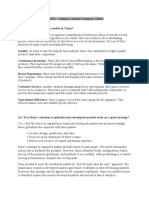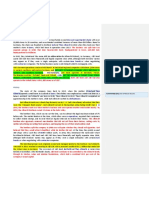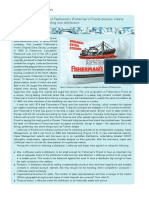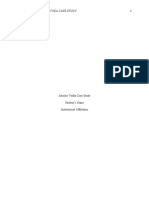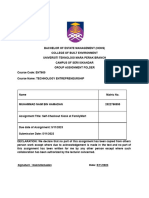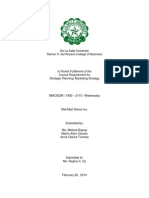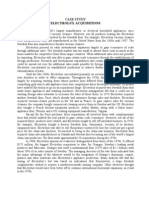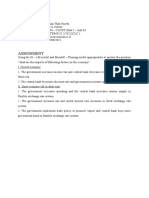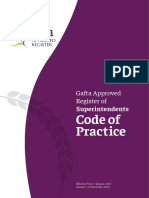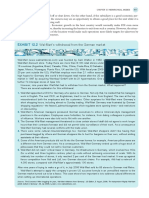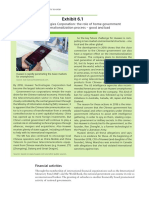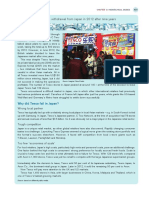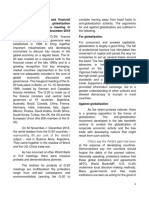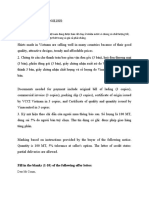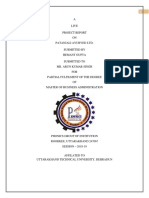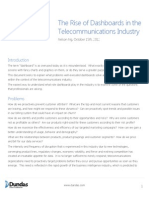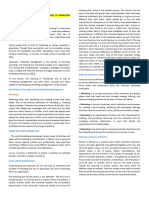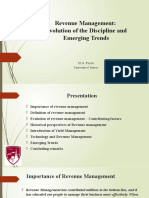Initiations of Internationalization - Internationalization of Haier (Exhibit 2.3)
Uploaded by
Phan DaraInitiations of Internationalization - Internationalization of Haier (Exhibit 2.3)
Uploaded by
Phan Dara60 Part I The decision whether to internationalize
Exhibit 2.3
Internationalization of Haier – proactive and reactive motives
Haier Group, the Chinese manufacturer of home attained through controlling services and market-
appliances (e.g. refrigerators), was near bank- ing/distribution, and ownership advantage had
ruptcy when Mr Zhang Ruimin was appointed been achieved by developing design and R&D capa-
plant director in 1984, the fourth one that year. It bilities through utilizing high-quality local human
is under Zhang’s leadership that the company has resources.
grown into the world’s sixth largest home appliance In 2016 Haier Group acquired General Electric Co’s
manufacturer. appliance business for $5.4 billion, the Chinese com-
pany’s latest attempt to boost its presence in the
Proactive motives lucrative United States market.
Zhang Ruimin had an internationalization mindset
Reactive motives
that set the initial stage of Haier’s development. In
1984, soon after joining the plant, he introduced The entry of global home appliance manufacturers
technology and equipment from Liebherr, a Ger- into the Chinese market forced Haier to seek inter-
man company, to produce several popular refriger- national expansion. In particular, since China joined
ator brands in China. At the same time he actively the WTO, almost every international competitor has
expanded cooperation with Liebherr by manufac- invested in China, establishing wholly-owned compa-
turing refrigerators based on its standards which nies. The best defensive strategy for Haier would be
were then sold to Liebherr, as a way of entering the to have a presence in its competitors’ home markets.
German market. In 1986, the value of Haier’s exports The saturation of the Chinese home appliance
reached US$3 million for the first time. Zhang later market, with intensifying competition, has been a
commented on this strategy: ‘Exporting to earn for- major motive. After the mid-1990s, price wars broke
eign exchange was necessary at that time.’ out one after another in various categories of the
When Haier invested in a plant in the US, Zhang market. At the end of 2000, Haier’s market shares
thought it gained ___location advantage by setting up in China of refrigerators, freezers, air conditioners
plants overseas to avoid tariffs and reduce trans- and washing machines had reached 33, 42, 31 and
portation costs. Internalization advantage had been 31 per cent, respectively. The potential for further
development in the domestic market was
therefore limited.
One of the important external triggers for
the internationalization of Haier has been the
Copyright © 2019. Pearson Education Limited. All rights reserved.
Chinese government. Being an international
player, Haier gained some special conditions
that other Chinese companies could not obtain.
For instance, Haier had already been approved
to establish a financial company, to be the
majority shareholder of a regional commer-
cial bank, and to form a joint venture with a US
insurance company. Without its active pursuit
of internationalization, as well as a dominant
position in the home appliance sectors, it would
normally be impossible for a manufacturer to
A Haier store get approval to enter the financial sector.
Source: Sorbis/Shutterstock.
Source: based on Liu and Li (2002) and other public sources.
Hollensen, Svend. Global Marketing, Pearson Education Limited, 2019. ProQuest Ebook Central, http://ebookcentral.proquest.com/lib/hud/detail.action?docID=5994693.
Created from hud on 2020-10-15 07:31:16.
You might also like
- IMS - Bosch Security Systems (IMS in The Middle East For Fire Detection Systems)100% (1)IMS - Bosch Security Systems (IMS in The Middle East For Fire Detection Systems)6 pages
- Customer Relationship Management and The IDIC Model in Retail BankingNo ratings yetCustomer Relationship Management and The IDIC Model in Retail Banking12 pages
- Q2. Compare and Contrast Marketing Mix Elements of Wal-Mart US and Wal-Mart ChinaNo ratings yetQ2. Compare and Contrast Marketing Mix Elements of Wal-Mart US and Wal-Mart China5 pages
- RP Strategies To Crack Well-Guarded MarketsNo ratings yetRP Strategies To Crack Well-Guarded Markets1 page
- Procter and Gamble Case Analysis Assignment100% (1)Procter and Gamble Case Analysis Assignment3 pages
- Haier: Taking A Chinese Company Global: Anshul Bhatia Roll No - 253No ratings yetHaier: Taking A Chinese Company Global: Anshul Bhatia Roll No - 25327 pages
- Haier:: Taking A Chinese Company GlobalNo ratings yetHaier:: Taking A Chinese Company Global14 pages
- Strategic Management CIA - 3: Assignment On Company Analysis100% (1)Strategic Management CIA - 3: Assignment On Company Analysis8 pages
- International Expansion and Strategies of DiscountNo ratings yetInternational Expansion and Strategies of Discount13 pages
- LG Electronics Global Strategy in Emerging MarketNo ratings yetLG Electronics Global Strategy in Emerging Market18 pages
- Louis Vuitton Moet Hennessy: Expanding Brand Dominance in AsiaNo ratings yetLouis Vuitton Moet Hennessy: Expanding Brand Dominance in Asia27 pages
- Arcelik Home Appliances: International Expansion Strategy: Assignment-8 GROUP-B05No ratings yetArcelik Home Appliances: International Expansion Strategy: Assignment-8 GROUP-B055 pages
- Group 8: - Dilan Gowda - Chandreyee Dutta - Ishan Mudgalkar - Abhay Singh - Aishwarya Tirthgirikar - Garima VaishNo ratings yetGroup 8: - Dilan Gowda - Chandreyee Dutta - Ishan Mudgalkar - Abhay Singh - Aishwarya Tirthgirikar - Garima Vaish8 pages
- Mcdonald'S Market Entry Strategies: Global Strategic ManagementNo ratings yetMcdonald'S Market Entry Strategies: Global Strategic Management17 pages
- Aldi-A German Retailing Icon: FINAL CASE ANALYSIS - Sales & Operation PlanningNo ratings yetAldi-A German Retailing Icon: FINAL CASE ANALYSIS - Sales & Operation Planning6 pages
- COVID-19 A Guide to Self Preparedness for Crisis Management: 1, #2From EverandCOVID-19 A Guide to Self Preparedness for Crisis Management: 1, #25/5 (1)
- International Business - Haier Taking A Chinese Company Global100% (10)International Business - Haier Taking A Chinese Company Global22 pages
- Practice 1: Answer The Following Questions: Commercial Correspondence Unit 1: Letter Layout, Content and StyleNo ratings yetPractice 1: Answer The Following Questions: Commercial Correspondence Unit 1: Letter Layout, Content and Style2 pages
- Gafta Standard For Superintendents Guide WEBNo ratings yetGafta Standard For Superintendents Guide WEB7 pages
- Gafta Code of Practice Superintendents v2.0 December 2020100% (1)Gafta Code of Practice Superintendents v2.0 December 20206 pages
- International Marketing Environment - Huawei Technologies Corporation-The Role of Home GovernmentNo ratings yetInternational Marketing Environment - Huawei Technologies Corporation-The Role of Home Government1 page
- Sociocutural Environment - P-Time Versus M-TimeNo ratings yetSociocutural Environment - P-Time Versus M-Time2 pages
- International Marketing Environment - G-20 and The Economic and Financial CrisesNo ratings yetInternational Marketing Environment - G-20 and The Economic and Financial Crises2 pages
- 1. Áo sơ mi sản xuất ở Việt nam đang được bán rất chạy ở nhiều nước vì chúng có chất lượng tốt, kiểu dáng hấp dẫn, hợp thời trang và giá cả phải chăngNo ratings yet1. Áo sơ mi sản xuất ở Việt nam đang được bán rất chạy ở nhiều nước vì chúng có chất lượng tốt, kiểu dáng hấp dẫn, hợp thời trang và giá cả phải chăng2 pages
- 'Documents - Tips - Royal Enfield Project ReportNo ratings yet'Documents - Tips - Royal Enfield Project Report68 pages
- Chapter 6: Primary and Secondary Data Sources: Prepared by Group 5No ratings yetChapter 6: Primary and Secondary Data Sources: Prepared by Group 524 pages
- Typesofplans: Functional Area Plans Plans With Time Horizon Plans According To Frequency of UseNo ratings yetTypesofplans: Functional Area Plans Plans With Time Horizon Plans According To Frequency of Use22 pages
- The Rise of Dashboards in Telecommunications PDFNo ratings yetThe Rise of Dashboards in Telecommunications PDF3 pages
- Nintendo's Vision: Strong Commitment Towards Production and Marketing of Best Products and ServicesNo ratings yetNintendo's Vision: Strong Commitment Towards Production and Marketing of Best Products and Services28 pages
- Magic Quadrant For Business Intelligence and Analytics PlatformsNo ratings yetMagic Quadrant For Business Intelligence and Analytics Platforms40 pages
- Parsa REVISED Version Revenue Management Conference Paris Dec 22 2015No ratings yetParsa REVISED Version Revenue Management Conference Paris Dec 22 201539 pages
- Broiler Chicken Farm Business Plan by SlidesgoNo ratings yetBroiler Chicken Farm Business Plan by Slidesgo40 pages
- TWB Position Paper Pharmaceutical IndustryNo ratings yetTWB Position Paper Pharmaceutical Industry9 pages
- Frey Biomedical Inc: Process Line ConfigurationNo ratings yetFrey Biomedical Inc: Process Line Configuration3 pages
- Change in Anything Besides Price That Affects Demand Shifts The Demand CurveNo ratings yetChange in Anything Besides Price That Affects Demand Shifts The Demand Curve2 pages





